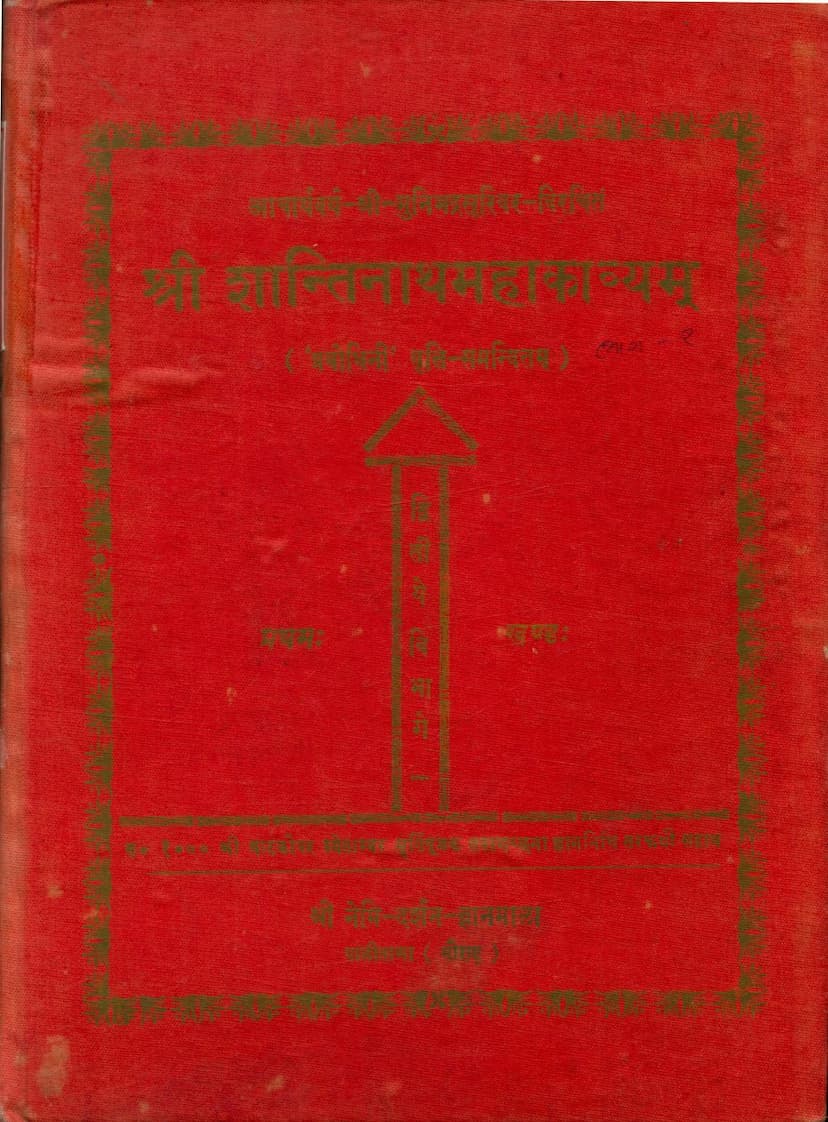Shantinath Mahakavyam Part 02
Added to library: September 2, 2025

Summary
Here's a comprehensive summary of the provided Jain text, "Shantinath Mahakavyam Part 02," based on the given pages:
Book Title: Shantinath Mahakavyam Part 02 Author: Acharya Munibhadra Suri Commentary (Vritti): Acharya Vijaydarshansuri Publisher: Nemidarshan Gyanshala, Palitana (Sauras2tra) Publication Year: Vikram Samvat 2022 (Shri Veer Nirwan Samvat 2492) Catalog Link: https://jainqq.org/explore/004313/1
Overall Nature of the Text:
This document is the second part of the Shantinath Mahakavyam, a large epic poem dedicated to the life and deeds of the 16th Jain Tirthankar, Lord Shantinath. This specific volume, the second part, contains four chapters (Sarg), from the fifth to the eighth. It includes a commentary called "Prabodhhini" written by Acharya Vijaydarshansuri. The text is presented in Sanskrit with a Gujarati translation provided alongside. The publisher, Nemidarshan Gyanshala, expresses gratitude to various donors and supporters for making this publication possible.
Key Highlights from the Content:
- Structure: The second part is divided into two sections, with this volume being the "first section" of the second part. It covers Sarg 5 to Sarg 8. The entire work is planned to be completed in three parts across four books.
- Content of Sarg 5:
- The fifth chapter begins with a mangal (auspicious invocation), describing Lord Shantinath and his qualities.
- It then delves into the geographical setting, describing Mount Vaitadhya in Bharat Kshetra, which divides the land into two parts and is home to Vidyadhar cities.
- The narrative introduces Chakrawal, a city located in the southern part of the Vaitadhya mountain range.
- It describes the king of this city, Jwalanjati, a powerful Vidyadhar king, his beautiful wife Vayuvega, and his accomplished son Arkakirti.
- The chapter also introduces Arkakirti's sister, Swayamprabha, whom the first Vasudeva, Trivrikshtha, marries.
- Jwalanjati renounces his kingdom after crowning Arkakirti and takes diksha (initiation).
- The narrative shifts to the previous lives of some characters, explaining the transmigration of souls.
- It details the birth of Lord Shreyansha in a previous life and the birth of Shri Vijay to Trivrikshtha and Swayamprabha.
- It further describes the birth of Vijaybhadra, Shri Vijay's younger brother, and Jyotishprabha, Shri Shreyansha's second wife.
- The story mentions the transmigration of Kapil, who becomes Ashanighosh, a powerful Vidyadhar king, in Champa city.
- The chapter concludes with the marriages of Shri Vijay to Sutara and Amittej (Arkakirti's son) to Jyotishprabha.
- The narrative also includes the story of Jvalanjati (Arkakirti's father) taking diksha and the subsequent departure of Baladeva (Achala).
- Key Themes Introduced in Sarg 5:
- The divine attributes of Lord Shantinath.
- The grandeur of Jain cosmology and geography (Mount Vaitadhya, Bharat Kshetra).
- The lives of royal families, marriages, and lineage.
- The concept of transmigration of souls and the influence of past karma.
- The renunciation of worldly pleasures and the path of spiritual liberation.
- The prowess and beauty of Vidyadhar characters.
- Sarg 6: This chapter seems to focus on the astrological prediction of a lightning strike on Shri Potanesh's city rather than on King Shri Vijay. It details the conversation between the king and a divine astrologer, the ministers' suggestions for protection, and the subsequent events related to the prediction. A significant portion describes how the city was protected by the timely intervention of a divine plan, preventing the lightning strike and leading to the worship of a divine statue. The chapter also narrates the story of Kapil's previous life as Ashanighosh and his eventual spiritual liberation, contrasting his worldly attachments with the path of detachment.
- Sarg 7: This chapter appears to continue the narrative of Amittej and Shri Vijay's lives. It details their marriages and subsequent activities. It also continues the story of Kapil's previous life as Ashanighosh, his adventures, and his eventual renunciation and spiritual attainment. The commentary highlights complex philosophical and ethical points.
- Sarg 8: This chapter seems to focus on Kapil's future lives and spiritual journey. It describes his birth as Dharmil, his penance, and his eventual rise to a divine state. It also continues the stories of the kings and their actions, including the consequences of their deeds and their paths towards liberation. A significant portion is dedicated to the story of Dhanad, his actions, his interactions with the king, his downfall, and his eventual spiritual realization. It also includes detailed descriptions of festivals, divine interventions, and the importance of righteous conduct.
Commentary and Translation:
- The commentary by Acharya Vijaydarshansuri ("Prabodhhini") is thorough, explaining the verses in detail, elaborating on philosophical concepts, and providing Gujarati translations for better understanding.
- The Gujarati translation aims to convey the essence of the original Sanskrit text, making the epic accessible to a wider audience.
Overall Impression:
The "Shantinath Mahakavyam Part 02" is a significant work in Jain literature, offering a detailed narrative of Lord Shantinath's life, interspersed with stories of other important figures and philosophical teachings. The inclusion of the commentary and translation makes it a valuable resource for understanding Jain philosophy, ethics, and the Tirthankar's life journey. The text emphasizes the importance of righteous conduct, renunciation, and the pursuit of spiritual liberation through adherence to Jain principles.